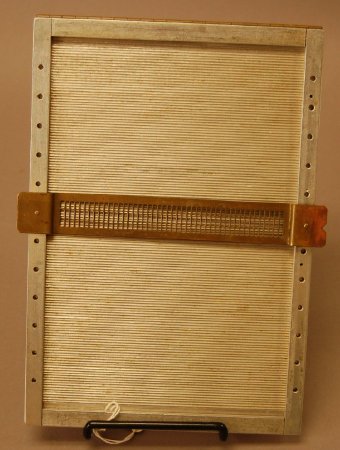Object ID:
2001.211.113
Title:
Ballu slate
Description:
Board slate for writing 10-dot Ballu; aluminum board has furrows, pins, and a top-hinged frame; brass guide is notched on one end and has 2 pegs on back to fit holes in frame; 1 line of 46 columns. "632" --front of guide. "632" and "Istituto Dei Ciechi Napoli Paolo Colosimo" --front of frame. A stylus was used with the Ballu slate to make tactile print, by embossing dots in the shapes of letters of the Roman alphabet.
Dimensions:
H-10 W-7 inches
Date:
n.d.
Made by:
Istituto Paolo Colosimo, Napoli
Place of Origin:
Naples, Italy
Provenance:
The Ballu system of embossing tactile print, by embossing dots in the shapes of letters of the Roman alphabet, was invented by Victor Ballu (1829-1907) in 1865. Ballu was a student of Louis Braille and later a professor (of piano) at the National Institute for Blind Youth in Paris, France. He was blind himself, and is also credited with developing interpoint braille printing in France. His Ballu slates, designed to write his system, were also manufactured and used across Europe.
Item is part of a slate collection that belonged to David Ronecker (1918-2001). He was blind since birth, attended the Missouri School for the Blind, worked in Texas as a medical technician for the armed forces, and was an avid collector of slates. He was the uncle of Charles Zinser, who acquired the slate collection after Ronecker's death.
The Paolo Colosimo Institute for the Blind was founded in Naples in 1892 as an offshoot of the National Society Regina Margherita for the Blind in Florence. Its name was changed in 1913 to memoralize the lost son of wealthy benefactors.
Item is part of a slate collection that belonged to David Ronecker (1918-2001). He was blind since birth, attended the Missouri School for the Blind, worked in Texas as a medical technician for the armed forces, and was an avid collector of slates. He was the uncle of Charles Zinser, who acquired the slate collection after Ronecker's death.
The Paolo Colosimo Institute for the Blind was founded in Naples in 1892 as an offshoot of the National Society Regina Margherita for the Blind in Florence. Its name was changed in 1913 to memoralize the lost son of wealthy benefactors.
Credit Line:
Museum Purchase, 2001.211
